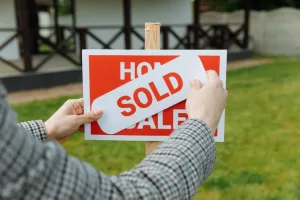NYC Tax Abatements Guide in New York
Go Back To Previous PageIf you are searching to buy an apartment or home in NYC, you may have come across numerous references to tax abatements in the various online listings. Whether you are familiar with the concept of property tax abatement in NYC or not, you would likely prefer to pay less in property taxes if possible. To help you learn more about these cost-saving property benefits, including the most widely known real estate tax abatements and exemptions, the team from NestApple has compiled a NYC Tax Abatements Guide for buyers.
What is a property tax abatement vs exemption in NYC?
A residential tax abatement program is a local government initiative, like the one in New York City, that reduces the real property tax bill on specific residential properties. The primary goal of these programs is to encourage the development or renovation of residential properties in particular areas of the city.
primary goal of these programs is to encourage the development or renovation of residential properties in particular areas of the city.
Advocates of tax abatements believe that tax breaks on real estate can create more construction jobs, help revitalize neighborhoods, and boost a region’s tax base by making affordable housing units available to its residents.
However, critics argue that such abatement programs can also lead to a surge in development, which may result in the displacement of long-term residents and property owners from their communities.
Real estate tax exemptions are a way to reduce the property tax bill for certain property owners who meet specific requirements. These requirements may include household income thresholds or other criteria. To receive such tax exemptions, property owners usually need to apply.
What NYC tax abatements and exemptions are available?
There are several tax abatement and exemption programs available in New York City.
The most frequently discussed abatements by apartment buyers are 421a, 421g, J-51, and the co-op and condo tax abatement. The most common tax exemptions discussed are the STAR, Enhanced STAR, and SCHE exemptions.
Types of tax abatements and exemptions in NYC
- 421a abatement
- 421g abatement
- J-51 exemption and abatement
- Cooperative and condominium tax abatement
- Eco-friendly abatements
- STAR, Enhanced STAR exemptions
- SCHE exemption
- Veteran, Good Samaritan, and Clergy exemptions
What is a 421a tax abatement?
The 421a tax abatement is the most widely discussed tax abatement in NYC. Almost twice as many buildings receive 421a abatements as the next most common type of residential abatement.
The 421a program started in 1971 and is named after the New York Property Tax Law section number. Its main objective was to incentivize real estate developers to build multi-unit residential buildings and thereby increase the availability of affordable housing in New York City.
“Depending on the approval, the 421a tax savings can last for 10 to 25 years.”
Term lengths of 421a tax abatements and codes
- 10-year term (Code 5110, 5117)
- 15-year term (Code 5113, 5118)
- 20-year term (Code 5116)
- 25-year term (Code 5114)
421a tax abatement benefits
The 421a tax abatement program in NYC significantly reduces property taxes for a specific period. The duration of the abatement term determines the extent of savings you receive during your ownership. Longer terms, like 25 years, provide more significant savings than shorter ones, like ten years. However, the tax benefits gradually phase out after construction, and the property becomes fully taxable once the abatement period expires.
To fully understand the advantages of a 421a abatement, it is essential to know the original duration of the building’s abatement and when it is set to expire. This will give you an idea of which phase-out plan is in place before your taxes revert to their usual rate. Before signing a purchase agreement, request that your real estate lawyer confirm the expiration date of the 421a tax abatement.
How are 421a tax abatements in NYC calculated?
The amount of a 421a abatement varies according to the percentage of property tax abated in the benefit year. The abatement percentage starts at 100% in the first benefit year and decreases gradually based on a set schedule throughout 10, 15, 20, or 25 years.
Once the abatement term ends, the property becomes fully taxable. During your due diligence, you can verify tax abatements by reviewing property records and consulting with your real estate attorney or the managing agent.
The table below displays the schedule for phasing out the 421a abatement term length.
| Benefit Year | 10-year Term | 15-year Term | 20-year Term | 25-year Term |
| 1 | 100% | 100% | 100% | 100% |
| 2 | 100% | 100% | 100% | 100% |
| 3 | 80% | 100% | 100% | 100% |
| 4 | 80% | 100% | 100% | 100% |
| 5 | 60% | 100% | 100% | 100% |
| 6 | 60% | 100% | 100% | 100% |
| 7 | 40% | 100% | 100% | 100% |
| 8 | 40% | 100% | 100% | 100% |
| 9 | 20% | 100% | 100% | 100% |
| 10 | 20% | 100% | 100% | 100% |
| 11 | Fully Taxable | 100% | 100% | 100% |
| 12 | 80% | 100% | 100% | |
| 13 | 60% | 80% | 100% | |
| 14 | 40% | 80% | 100% | |
| 15 | 20% | 60% | 100% | |
| 16 | Fully Taxable | 60% | 100% | |
| 17 | 40% | 100% | ||
| 18 | 40% | 100% | ||
| 19 | 20% | 100% | ||
| 20 | 20% | 100% | ||
| 21 | Fully Taxable | 100% | ||
| 22 | 80% | |||
| 23 | 60% | |||
| 24 | 40% | |||
| 25 | 20% | |||
| 26 | Fully Taxable |
What is a 421g tax abatement?
The 421g tax abatement program started after the 421a program in the mid-1990s to incentivize the conversion of commercial buildings in Downtown Manhattan into residential spaces. This program offers property tax benefits for conversion projects below City Hall and south of Murray Street in Tribeca.
Abatements for properties under 421g lasted for either 12 years (for non-landmark buildings) or 13 years (for landmark buildings). During these abatement periods, property taxes on non-landmark buildings were entirely waived for the first eight years post-construction. After that, the taxes decreased by 20% annually until the property became fully taxable.
For landmark buildings, the taxes were fully waived for the first nine years, after which they decreased by 20% per year until they were fully taxable.
The deadline for new 421g applications was December 30, 2007. The tax breaks are expiring for the last buildings in 2020.
What is a J-51 abatement?
The J-51 program is unique because it combines a tax exemption and a tax abatement, and is less well-known than the 421a program.
The J-51 abatement is a program designed to encourage the development of affordable housing. It is similar to the 421a program, but it has a more complex structure and focuses on renovating run-down residential properties or converting commercial structures into residential ones.
The J-51 abatement process works in two steps.
- First, a tax exemption is granted that ensures that the assessed value of the property remains the same as it was before any construction or renovation.
- Second, a tax abatement is provided that reduces the property taxes owed after the construction or renovation is complete. This helps incentivize property owners to invest in their properties while keeping their tax burden low.
What is the NYC cooperative and condominium tax abatement?
Co-op and condo tax abatement program in NYC helps co-op and condo owners reduce their property taxes. If the owners meet specific eligibility requirements, the abatement can reduce property taxes by 17.5% to 28.1%.
The abatement applies only to co-op and condo owners who use the unit as their primary residence, not those who purchased a condo unit as an investment property.
Requirements of the co-op and condo tax abatement
- must be the owner’s primary residence
- purchased before January 5th to be eligible for that tax year
- owner cannot own more than three units in a building
- owner cannot be receiving a J-51, 421a, 421b, 421g, or 420c abatement
- not owned by a business entity or trust
- not located in an HDFC building
Suppose a co-op or condo owner satisfies the eligibility criteria and is approved for the abatement. In that case, they can receive an annual reduction in property taxes on their unit. The reduction varies depending on the average assessed value of the unit, ranging from 17.5% to 28.1%.
NYC co-op and condo tax abatement savings per year
- Assessed value $50,000 or less: 28.1%
- Assessed value $50,001 to $55,000: 25.2%
- Assessed value $55,001 to $60,000: 22.5%
- Assessed value $60,001 or more: 17.5%
Eco-friendly property tax abatements in NYC
Eligible property owners can receive eco-friendly abatements for installing green or solar roofs.
The green roof abatement is a one-time property tax abatement for properties with green roofs. According to the NYC Department of Finance, a green roof is with “vegetation that absorbs rainwater, provides insulation and combats ‘the heat island effect,’ where urban environments can have higher temperatures than surrounding areas.”
The abatement for green roofs is $4.50 per square foot of the area designated as green roof space. The maximum abatement allowed is $100,000 or the amount of taxes due for the property in that taxable year, whichever is less.
Solar roof abatement is a tax benefit for properties that use solar panels on the roof of a building to generate electricity from renewable sources. The Department of Buildings assesses whether a property is eligible for this abatement. Property that already receives a 421-a, 421-b, or 421-g tax abatement is not eligible for this benefit.
Property tax exemptions NYC owners can apply for
- Basic STAR
- Enhanced STAR
- Senior Citizen’s Homeowner’s Exemption (SCHE)
- Veteran, Good Samaritan, and Clergy
Basic STAR
The School Tax Relief (STAR) exemption offers property tax savings of approximately $300 per year to owners of houses, co-ops, or condos in NYC with an annual household income of $250,000 or less.
Enhanced STAR
The enhanced version of the STAR exemption offers property tax savings of approximately $650 per year to New York City homeowners of houses, co-ops, or condos who are 65 years or older and have an annual household income of $88,050 or less.
SCHE
The Senior Citizen’s Homeowner’s Exemption (SCHE) is a program that provides property tax savings to homeowners in New York City who meet certain criteria. Eligible homeowners are 65 or older and have an annual household income of $58,399 or less. Under the program, homeowners can receive a reduction of up to 50% on the assessed value of their property, whether it is a house, co-op, or condo.
Veteran, Good Samaritan, and Clergy
Some additional exemptions are available for property owners who qualify under certain conditions. These conditions include being a veteran of the United States military, becoming disabled during a crime or in an attempt to prevent a crime, or being a member of the clergy. The amount of exemption may vary depending on the situation.
For a full list of tax exemptions and abatements, visit the NYC Department of Finance website.
How do you verify a tax abatement in NYC?
Real estate agents often mention tax abatements in listings as they can be attractive to buyers.
But you don’t have to take the listing agent’s word for it. Buyers can independently verify an abatement via the NYC Department of Finance website.
What you need to input for NYC abatement verification
- NYC Borough
- Building Number
- Street
- Apartment #
After entering the apartment’s address information, you will be directed to a search result page. Once you’re there, simply click on “Benefits—Business & Construction” on the left-hand menu bar. This will allow you to see if the apartment has any exemptions. Additionally, you can review the amount for the current tax period and the proposed amount for the next tax period.


